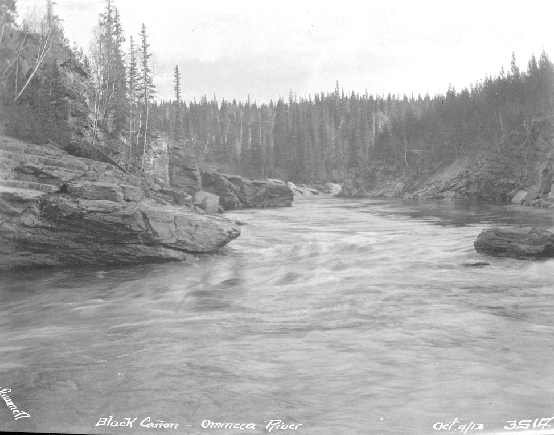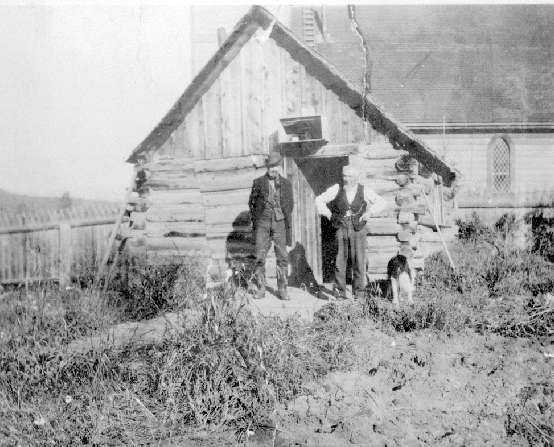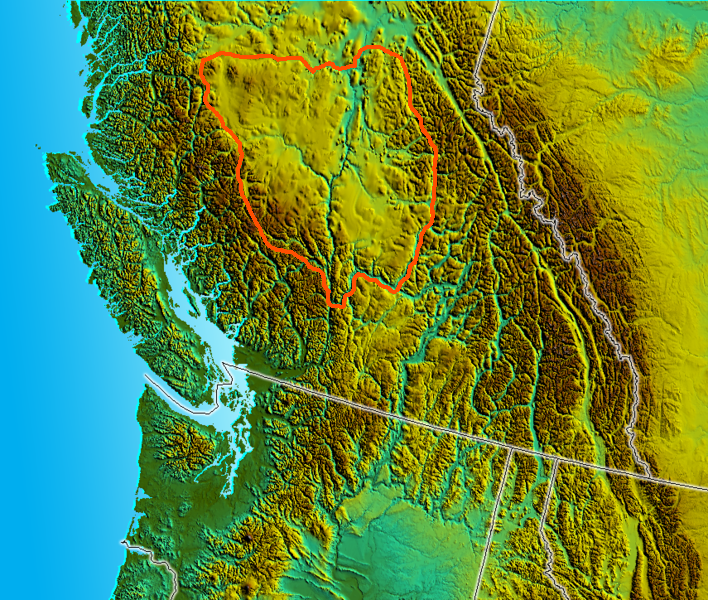|
Omineca Mining District
The Omineca Country, also called the Omineca District or the Omineca, is a historical geographic region of the Northern Interior of British Columbia, roughly defined by the basin of the Omineca River but including areas to the south which allowed access to the region during the Omineca Gold Rush of the 1860s. The term Omineca District also refers to the Omineca Mining District which referred to the same area but was a government administrative division. Today the name loosely refers to the region northwest of Prince George and north of Hwy 16 (the Yellowhead Highway) and occurs in the names of such entities as electoral districts, e.g. Prince George-Omineca. See also *Cariboo *Chilcotin District * Lost Creek *Peace River Block * Slate Creek *Stikine Country The Stikine Country , also referred to as the Stikine District or simply "the Stikine", is one of the historical geographic regions of the Canadian province of British Columbia, located inland from the central Alaska Panh ... [...More Info...] [...Related Items...] OR: [Wikipedia] [Google] [Baidu] |
British Columbia Interior
, settlement_type = Region of British Columbia , image_skyline = , nickname = "The Interior" , subdivision_type = Country , subdivision_name = , subdivision_type1 = Province , subdivision_name1 = , parts_type = Principal cities , p1 = Kelowna , p2 = Kamloops , p3 = Prince George , p4 = Vernon , p5 = Penticton , p6 = West Kelowna , p7 = Fort St. John , p8 = Cranbrook , area_blank1_title = 14 Districts , area_blank1_km2 = 669,648 , area_footnotes = , elevation_max_m = 4671 , elevation_min_m = 127 , elevation_max_footnotes = Mt. Fairweather , elevation_min_footnotes = Fraser River , population_as_of = 2016 , population = 961,155 , population_density_km2 ... [...More Info...] [...Related Items...] OR: [Wikipedia] [Google] [Baidu] |
Omineca River
Omineca River is a river of the North American boreal forest, in northern British Columbia, Canada. It flows into the Williston Lake, and is part of the Peace River basin. It was originally a tributary of the Finlay River before the creation of Lake Williston. According to Father Adrien-Gabriel Morice the name is derived from a Sekani word meaning 'lake-like or sluggish river'. Tributaries * Ominicetla Creek *Germansen River *Osilinka River *Mesilinka River Mesilinka River is a river in the Canadian boreal forest. It is located in the province of British Columbia, approximately 3,500 km west of the national capital, Ottawa, and about 900 km north of the provincial capital, Victoria Victoria mo ... References * Rivers of British Columbia Omineca Country Cassiar Land District {{BritishColumbiaInterior-river-stub ... [...More Info...] [...Related Items...] OR: [Wikipedia] [Google] [Baidu] |
Omineca Gold Rush
The Omineca Gold Rush was a gold rush in British Columbia, Canada in the Omineca region of the Northern Interior of the province. Gold was first discovered there in 1861, but the rush didn't begin until late in 1869 with the discovery at Vital Creek. There were several routes to the goldfields: two were from Fort St. James, one of which was a water route through the Stuart and Tachie Rivers to Trembleur Lake to Takla Lake and the other was overland, called the Baldy Mountain route. A third route came in overland from Hazelton on the Skeena River and a fourth route used the Fraser River and crossed over the Giscome Portage to Summit Lake, through McLeod Lake, and up the Finlay River to the Omineca River. 1860s Toy's Bar The first recorded gold discovery in the Omineca district was made by William Cust and Edward Carey in the summer of 1861. The two men had traveled up from Alexandria that spring and returned in the fall with 60 ounces of gold between them. Despite such a small ... [...More Info...] [...Related Items...] OR: [Wikipedia] [Google] [Baidu] |
Omineca Mining District
The Omineca Country, also called the Omineca District or the Omineca, is a historical geographic region of the Northern Interior of British Columbia, roughly defined by the basin of the Omineca River but including areas to the south which allowed access to the region during the Omineca Gold Rush of the 1860s. The term Omineca District also refers to the Omineca Mining District which referred to the same area but was a government administrative division. Today the name loosely refers to the region northwest of Prince George and north of Hwy 16 (the Yellowhead Highway) and occurs in the names of such entities as electoral districts, e.g. Prince George-Omineca. See also *Cariboo *Chilcotin District * Lost Creek *Peace River Block * Slate Creek *Stikine Country The Stikine Country , also referred to as the Stikine District or simply "the Stikine", is one of the historical geographic regions of the Canadian province of British Columbia, located inland from the central Alaska Panh ... [...More Info...] [...Related Items...] OR: [Wikipedia] [Google] [Baidu] |
Prince George, British Columbia
Prince George is the largest city in northern British Columbia, Canada, with a population of 74,004 in the metropolitan area. It is often called the province's "northern capital" or sometimes the "spruce capital" because it is the hub city for Northern BC. It is situated at the confluence of the Fraser and Nechako rivers, and at the crossroads of Highway 16 and Highway 97. History The origins of Prince George can be traced to the North West Company fur trading post of Fort George, which was established in 1807 by Simon Fraser and named in honour of King George III.Runnalls, F.E. A History of Prince George. 1946 The post was centred in the centuries-old homeland of the Lheidli T'enneh First Nation, whose very name means "people of the confluence of the two rivers." The Lheidli T'enneh name began to see official use around the 1990s and the band is otherwise historically referred to as Fort George Indian Band.George, N. D. "Decolonizing the Empathic Settler Mind: An Autoethn ... [...More Info...] [...Related Items...] OR: [Wikipedia] [Google] [Baidu] |
British Columbia Highway 16
Highway 16 is a highway in British Columbia, Canada. It is an important section of the Yellowhead Highway, a part of the Trans-Canada Highway that runs across Western Canada. The highway closely follows the path of the northern B.C. alignment of the Canadian National Railway. The number "16" was first given to the highway in 1941, and originally, the route that the highway took was more to the north of today's highway, and it was not as long as it is now. Highway 16 originally ran from New Hazelton east to Aleza Lake. In 1947, Highway 16's western end was moved from New Hazelton to the coastal city of Prince Rupert, and in 1953, the highway was re-aligned to end at Prince George. In 1969, further alignment east into Yellowhead Pass was opened to traffic after being constructed up through 1968 and raised to all-weather standards in 1969. Highway 16's alignment on Haida Gwaii was commissioned in 1983 and is connected to the mainland segment via BC Ferries route #11. A series of ... [...More Info...] [...Related Items...] OR: [Wikipedia] [Google] [Baidu] |
Yellowhead Highway
The Yellowhead Highway (french: Route Yellowhead) is a major interprovincial highway in Western Canada that runs from Winnipeg to Graham Island off the coast of British Columbia via Saskatoon and Edmonton. It stretches across the four western Canadian provinces of British Columbia, Alberta, Saskatchewan, and Manitoba and is part of the Trans-Canada Highway system and the larger National Highway System, but should not be confused with the more southerly, originally-designated Trans-Canada Highway. The highway was officially opened in 1970. Beginning in 1990, the green and white Trans-Canada logo was used to designate the roadway. The highway is named for the Yellowhead Pass, the route chosen to cross the Canadian Rockies. The pass and the highway are named after a fur trader and explorer named Pierre Bostonais. He had yellow streaks in his hair, and was nicknamed "Tête Jaune" (Yellowhead). Almost the entire length of the highway is numbered as 16, except for the section in ... [...More Info...] [...Related Items...] OR: [Wikipedia] [Google] [Baidu] |
Prince George-Omineca
A prince is a male ruler (ranked below a king, grand prince, and grand duke) or a male member of a monarch's or former monarch's family. ''Prince'' is also a title of nobility (often highest), often hereditary, in some European states. The female equivalent is a princess. The English word derives, via the French word ''prince'', from the Latin noun , from (first) and (head), meaning "the first, foremost, the chief, most distinguished, noble ruler, prince". Historical background The Latin word (older Latin *prīsmo-kaps, literally "the one who takes the first lace/position), became the usual title of the informal leader of the Roman senate some centuries before the transition to empire, the ''princeps senatus''. Emperor Augustus established the formal position of monarch on the basis of principate, not dominion. He also tasked his grandsons as summer rulers of the city when most of the government were on holiday in the country or attending religious rituals, and, for ... [...More Info...] [...Related Items...] OR: [Wikipedia] [Google] [Baidu] |
Cariboo
The Cariboo is an intermontane region of British Columbia, Canada, centered on a plateau stretching from Fraser Canyon to the Cariboo Mountains. The name is a reference to the caribou that were once abundant in the region. The Cariboo was the first region of the interior north of the lower Fraser River and its canyon to be settled by non-indigenous people, and played an important part in the early history of the colony and province. The boundaries of the Cariboo proper in its historical sense are debatable, but its original meaning was the region north of the forks of the Quesnel River and the low mountainous basins between the mouth of that river on the Fraser at the city of Quesnel and the northward end of the Cariboo Mountains, an area that is mostly in the Quesnel Highland and focused on several now-famous gold-bearing creeks near the head of the Willow River. The richest of them all, Williams Creek, is the location of Barkerville, which was the capital of the Cariboo Gol ... [...More Info...] [...Related Items...] OR: [Wikipedia] [Google] [Baidu] |
Chilcotin District
The Chilcotin () region of British Columbia is usually known simply as "the Chilcotin", and also in speech commonly as "the Chilcotin Country" or simply Chilcotin. It is a plateau and mountain region in British Columbia on the inland lee of the Coast Mountains on the west side of the Fraser River. Chilcotin is also the name of the river draining that region. In the language of the Chilcotin people their name and the name of the river means "people of the red ochre river" (its tributary the Chilko River means "red ochre river") The Chilcotin district is often viewed as an extension of the Cariboo region, east of that river, although it has a distinct identity from the Cariboo District. It is, nonetheless, part of the Cariboo Regional District which is a municipal-level body governing some aspects of infrastructure and land-used planning. The vast majority of the population are First Nations people, members of the Tsilhqot'in and Dakelh peoples, while others are settlers and ran ... [...More Info...] [...Related Items...] OR: [Wikipedia] [Google] [Baidu] |
Lost Creek (British Columbia)
Lost Creek is a creek located in the Omineca Country region of British Columbia British Columbia (commonly abbreviated as BC) is the westernmost province of Canada, situated between the Pacific Ocean and the Rocky Mountains. It has a diverse geography, with rugged landscapes that include rocky coastlines, sandy beaches, .... The creek flows into the Manson River from the south and was discovered in 1871. Lost Creek has been mined by Europeans and Chinese miners. References External links * Rivers of British Columbia Cassiar Land District {{BritishColumbia-river-stub ... [...More Info...] [...Related Items...] OR: [Wikipedia] [Google] [Baidu] |
Peace River Block
The Peace River Block is an area of land located in northeastern British Columbia, in the Peace River Country. In exchange for building a rail line across Canada to British Columbia, the Canadian Pacific Railway was given the Railway Belt, of land on each side of the rail. To compensate the CPR for alienated or non-arable land in the wide strip, the Province allowed the Dominion government to take control of within B.C., northeast of the Rocky Mountains. This arrangement passed the provincial legislature on December 19, 1883, and passed the Dominion house on March 21, 1884, as the "Settlement Act". As all the land northeast of the Rocky Mountains became a provincial reserve pending the Dominion government's decision on what land to select prevented homesteading and land claims. After several surveys of the land the Dominion government took possession in 1907. The land the Dominion government chose was an approximately square-shaped block of land north-south and east-west. The ... [...More Info...] [...Related Items...] OR: [Wikipedia] [Google] [Baidu] |




